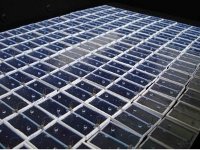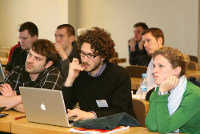 |
 |
|||||||||||||
|
|||||||||||||
|
|||||||||||||
|
Sometimes detector projects that are still at a planning stage can tell detector projects that are already taking data what hardware to use. This is certainly the case when the R&D project has been using, trying and testing a technology that the 'old hand' is considering for its upgrade: a relatively new type of sensor called Silicon Photo Multiplier, or SiPM, developed in Russia. A meeting brought experts from all areas that use SiPMs together at DESY in Hamburg, Germany, for two days earlier this week. The CALICE hadronic calorimeter (HCal) one of the possible options for a future detector at the ILC, is being developed and tested by groups from all over the world and has been using SiPMs for years. The final HCal will feature some eight million of these ultra-fast and ultra-precise photo detectors and an unprecedented resolution where each particle is reconstructed individually, and the team around CALICE spokesman Felix Sefkow are thus regarded as experts in their use. However, they are by far not the only team who is using SiPMs for their detectors — just like the term 'SiPM' can stand for a variety of different sensors who all work as multi-pixel avalanche photodiodes, meaning they can read and amplify single photons very efficiently. The meeting at DESY took stock of the different sensors built by different companies, participants compared characteristics and exchanged experiences. “These sensors are obviously a hot topic in physics,” says Kerstin Borras, leader of DESY's CMS group and the initiator of the meeting. “We expected some 20 participants, in the end we had more than twice as many registrations: 45 people from 20 institutes in eight countries.” Her own experiment, the CMS detector at the LHC, is planning to use SiPMs for future upgrades in two of its subdetectors: the CMS HCal group plans to replace the present photon detectors with SiPMs, and the MTT (Muon Track Tag) group is investigating whether adding a layer a scintillators equipped with SiPMs could improve the CMS muon trigger. Silicon PMs have a broad range of applications, for example they play an important role in the developments of more efficient and more customised positron emission tomographs or PET scanners for medical uses. There are different companies around the world who build the photomultipliers, and participants left with a complete grid of sensor characteristics — size, amplification, dynamic range, recovery time, radiation hardness, resistance to magnetic fields, voltage and temperature dependence and many more. Depending on the project they now have a better idea which sensor to use for their purposes. Last point on the agenda: sight-seeing of the first large array of working SiPMs — the CALICE HCal prototype, currently resting from test beam activity at DESY, and the first modules of a second generation prototype with fully integrated electronics. Because it is a hot current topic, this exchange of experiences between the communities was sponsored by the Landesexzellenzcluster 'Connecting Particles with the Cosmos' in Hamburg. Directly after this workshop the third annual meeting of the Helmholtz-Russia Joint Research Group (HRJRG) took place, meaning that promising young Russian researchers supported by this programme could participate in this international event. In the HRJRG DESY collaborates with the inventor-institute MEPHI as well as with the other two Moscow institutes ITEP and MSU. Topics in this research group are of course the SiPMs, calorimetry and physics at the LHC and the ILC. -- Barbara Warmbein |
|||||||||||||
| © International Linear Collider |

